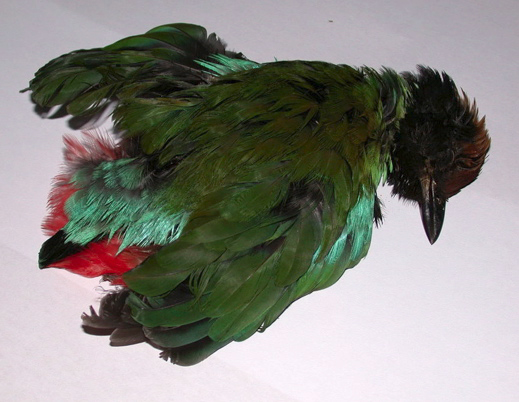It all started when KC Tsang found a dead Hooded Pitta (Pitta sordida) at Kang Choo Bin Road on the evening of 13th November 2007. This is an uncommon winter visitor and passage migrant and KC thought that someone might want it for a museum specimen.

The forum discussion on the dead pitta attracted the attention of Mike Donahue of Seattle who wrote:
“Avian specimens in museum collections are libraries of biological material and provide a wealth of information: they have tremendous value for studies on taxonomy, systematics, biogeography, distribution, geographical variation, anatomy, molt and plumage sequences, morphology, age and sex differences, migration, and timing of reproduction. …The same specimens can be used repeatedly to answer a number of biological questions. If stored and handled properly they can last for hundreds of years.
“An under appreciated value of museum collections is their role in conservation. For example, feathers can be analyzed for the presence of heavy metals and different forms of carbon and nitrogen. This provides information about the bird’s environment and can be used to track changes over time. The role of DDT in egg shell thinning was established in part by examining eggs in museums that were collected prior to the use of DDT.
“Studies of molt have been able to identify geographic regions that may be critical during the molting period. Why is it necessary to continue adding to museum collections? Birds vary by season, sex, and age, often wearing more than one plumage over the course of a year. They vary geographically, and some can take several years (up to 10 in some albatrosses) before they reach plumage maturity. A large number of specimens of each species are necessary in order to adequately represent all of this variability.
“…An adequate number of specimens to examine are required in order to determine any meaningful patterns. What was understood about Arctic Tern molt for years was based on an examination of 15 specimens, only 5 of which were in molt. A further study of 338 specimens that included 81 in molt revealed that the previous conclusions about their molt pattern were incorrect.
“The bottom line is: Don’t assume that the House Finch or Fox Sparrow that hits your window is “just a common bird” and isn’t valuable!
“To store specimens: Stuff a small piece of tissue in the mouth of the bird. Wrap the bird in a piece of newspaper. If the bird is large, fold the head and legs around the body to form a compact package before wrapping.
“Put the bird in a plastic bag and squeeze out the extra air. Specimens can be kept for months in the freezer, but a lengthy storage can cause freezer burn, which makes the specimens more difficult to prepare, and often causes damage to the gonads. So don’t let them sit in your freezer for too long!
“Recording data: The locality and date found are the most important pieces of information to record. Also include your name and phone number and manner of collection (road kill, window kill, etc).”
The Raffles Museum of Biodiversity Research, National University of Singapore, has a collection of dead bird specimens and welcomes more. Please contact Wang Luan Keng at 65163011 or e-mail her at [email protected]. Specimens should be kept in plastic bags (double bagged), kept cool or frozen, if possible. Specimens should be labelled, noting the date collected, location found and person who found it. Also cause of death if available.
NOTE: Those who are uncomfortable about collecting dead birds, considering bird flu, etc, please contact RMBR.
KC Tsang & Mike Donahue
Singapore
April 2009









2 Responses